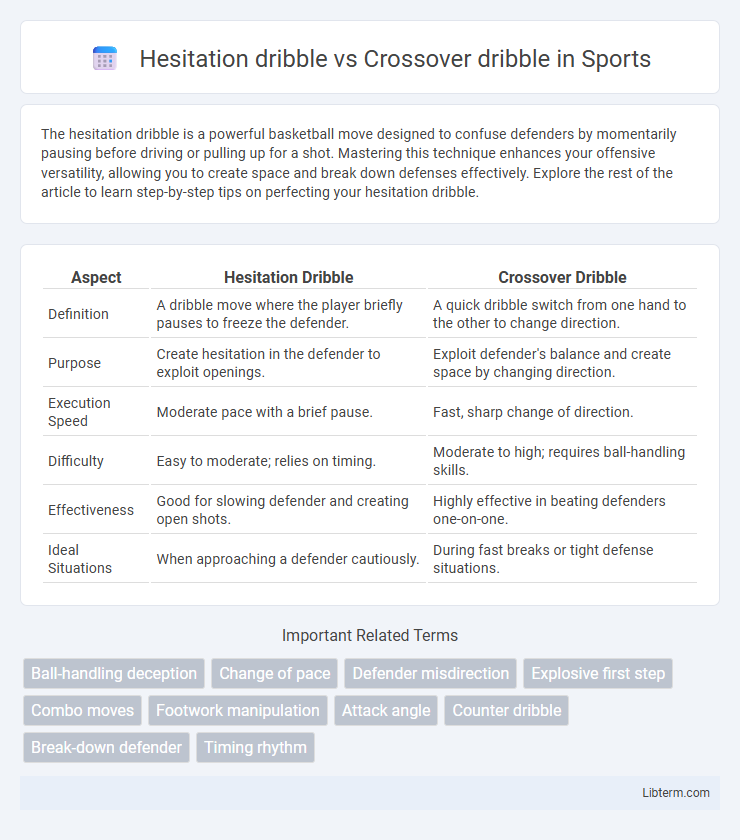The hesitation dribble is a powerful basketball move designed to confuse defenders by momentarily pausing before driving or pulling up for a shot. Mastering this technique enhances your offensive versatility, allowing you to create space and break down defenses effectively. Explore the rest of the article to learn step-by-step tips on perfecting your hesitation dribble.
Table of Comparison
| Aspect | Hesitation Dribble | Crossover Dribble |
|---|---|---|
| Definition | A dribble move where the player briefly pauses to freeze the defender. | A quick dribble switch from one hand to the other to change direction. |
| Purpose | Create hesitation in the defender to exploit openings. | Exploit defender's balance and create space by changing direction. |
| Execution Speed | Moderate pace with a brief pause. | Fast, sharp change of direction. |
| Difficulty | Easy to moderate; relies on timing. | Moderate to high; requires ball-handling skills. |
| Effectiveness | Good for slowing defender and creating open shots. | Highly effective in beating defenders one-on-one. |
| Ideal Situations | When approaching a defender cautiously. | During fast breaks or tight defense situations. |
Introduction: Understanding Basketball Dribbling Techniques
Hesitation dribble and crossover dribble represent two fundamental basketball techniques used to deceive defenders and create scoring opportunities. The hesitation dribble involves momentarily pausing during a drive to disrupt the defender's timing, while the crossover dribble rapidly shifts the ball from one hand to the other to change direction. Mastering both techniques enhances ball control, agility, and offensive unpredictability on the court.
What is a Hesitation Dribble?
A hesitation dribble involves momentarily slowing down or pausing while dribbling to deceive the defender into thinking the ball handler is about to stop or change direction. This move creates an opening by causing the defender to hesitate or react prematurely, allowing the offensive player to accelerate past them. Unlike a crossover dribble, which primarily relies on a quick, lateral ball switch, the hesitation dribble emphasizes timing and sudden changes in tempo to disrupt defensive positioning.
What is a Crossover Dribble?
A crossover dribble is a basketball move where the player swiftly switches the ball from one hand to the other to change direction and evade defenders. This technique enhances agility and creates space, making it difficult for opponents to anticipate the player's next move. Mastering the crossover dribble improves ball control and offensive effectiveness by enabling quick, deceptive shifts in momentum.
Key Differences Between Hesitation and Crossover Dribbles
The hesitation dribble uses a sudden pause or slowdown to mislead defenders into expecting a stop or shot, creating space for a drive or shot. In contrast, the crossover dribble involves a quick, lateral ball transfer between hands to swiftly change direction and deceive defenders. Key differences include the hesitation's focus on timing and pace manipulation versus the crossover's emphasis on rapid change of direction and hand coordination.
Advantages of Using the Hesitation Dribble
The hesitation dribble effectively creates confusion and hesitation in the defender, allowing the ball handler to exploit openings and drive past opponents with increased success. This move enhances offensive versatility by combining a subtle pause with quick acceleration, improving scoring opportunities in tight defenses. By disrupting defensive timing, the hesitation dribble offers an edge in one-on-one situations that can lead to easier penetration and higher-percentage shots.
Benefits of Mastering the Crossover Dribble
Mastering the crossover dribble enhances a player's ability to quickly change direction and deceive defenders, creating open driving lanes and scoring opportunities. This advanced ball-handling move improves agility, hand-eye coordination, and court vision, allowing for better control under pressure. Compared to the hesitation dribble, the crossover is more effective in breaking down defenses and initiating fast breaks, making it a crucial skill for offensive dominance.
When to Use Hesitation Dribble in a Game
The hesitation dribble is most effective when approaching a defender to disrupt their timing and create space for a shot or drive, particularly during isolation plays or late clock situations. It works best when the defender is aggressive or playing tight on the ball, allowing the offensive player to freeze or slow the defender momentarily. Using the hesitation dribble at the top of the key or on the wing maximizes its potential to generate open looks or driving lanes.
Situations Best Suited for the Crossover Dribble
The crossover dribble is best suited for situations requiring sudden direction changes to evade defenders, especially in one-on-one isolation plays or when creating space for a shot or drive. It excels in fast-break scenarios and in half-court sets where quick lateral movement can break defensive pressure. The move effectively exploits defenders caught off-balance, making it ideal for penetrating tight defenses or setting up scoring opportunities.
Tips for Improving Both Dribbling Techniques
Mastering the hesitation dribble requires practicing sudden pauses combined with controlled ball handling to deceive defenders effectively. For the crossover dribble, concentrate on quick, low, and sharp hand movements to switch the ball between hands while maintaining body balance and eye contact with the basket. Consistent drills that emphasize footwork, ball control, and change of pace significantly enhance both hesitation and crossover dribbling skills, improving overall basketball performance.
Conclusion: Choosing the Right Move for Your Playstyle
The hesitation dribble excels at creating space and confusing defenders with subtle pauses, ideal for players who rely on timing and finesse. The crossover dribble leverages quick, explosive changes in direction to beat defenders off the dribble, suiting athletes with strong agility and speed. Selecting the right move depends on your individual strengths and offensive strategy, optimizing effectiveness by matching the dribble type to your playstyle and game situation.
Hesitation dribble Infographic

 libterm.com
libterm.com